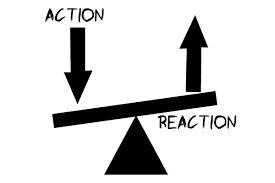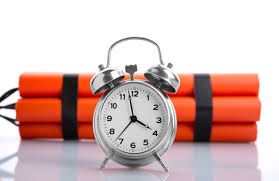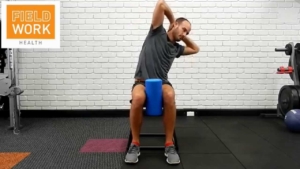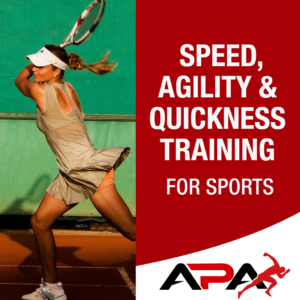Is Your Training Sport Specific?
There are two comments or requests that parents regularly make to me. The first one is about lifting weights- some parents are against their child doing anything more than bodyweight until after puberty so want to check that I won’t be doing that. That conversation usually happens before we start working together. I think I’ll be spending my entire career busting that myth that weight training before 16 stunts your growth! But that topic is for another post.
The Training isn’t Sport Specific
The second one usually comes a little while into the working relationship. It usually happens after the parent has either observed a bit of the session or has been given feedback by their child. It goes a little something like this, ”I’m concerned that my child is not doing sport specific training. If s/he’s not going to be doing exercises that will help with their [insert sport] then I’d rather not continue.”
To me the two comments are interesting because to me they’ve got their priorities back to front- it’s like putting the cart before the horse. They want to do all the exercises with a speed component first. But likely they don’t have muscle balance, or they can’t go through their full range of motion, and they’re not very strong.
For the parents asking for sport specificity it seems to me that building the basic qualities of athleticism (the ones I just mentioned above) isn’t valued. Now if they also ask me not to do weights then we have some real challenges because they are effectively asking me to fire a cannon from a canoe!
Newton’s Third Law
What exactly is that key ingredient that many sports have in common with each other? To me, what stands out is this: most sports require us to efficiently transfer energy from the heaviest part of the body to a lighter part of the body. I specialise in working in Tennis, which is a rotational sport where the first critical event in the kinematic sequence, before rotation starts in the tennis swing, is the ground reaction to the applied force (what we often refer to as ground reaction force).
This occurs when an athlete attempts to gather energy in their lower body by pushing into the ground so that essentially the ground pushes back and this energy release is transferred up the body in an efficient sequence. Thus having great footwork to get into the best stance ready to hit the shot is key. It’s also why you hear the tennis coaches shout ‘use your legs!’ all the time.
But because this ground reaction force is something that isn’t observable to the eye (unless they are doing it on a force platform with a TV monitor!) it gets overlooked. This is because the energy works its way up the chain so that you can observe maximal speed in the distal segment or implement (bat, racket, club) but you just don’t see where the energy came from. So you are only concerned with seeing your child do things in the gym that mirror those movement speeds you saw on the court.
Now don’t get me wrong we mustn’t be afraid of getting sport specific- and in fact everything we are doing to get the body moving more efficiently (read that as moving better) in a general sense, is so that we can transfer all the energy into a sport specific task, rather than it leaking out as we compensate by using the wrong muscles to do the work. Or we use the right muscles but they aren’t strong enough to handle the task.
This is why I sometimes have to challenge the idea that general training (any training that doesn’t exactly replicate the sporting action is general to some degree) isn’t sport specific. If it is going to help improve a specific task indirectly then in my book it is specific. It is certainly athlete specific even if it isn’t task specific (or sport specific) because it is still improving the athlete’s ability to execute in their sport!!! We are just getting to it one step at a time.
Driving to a final destination in a car we have to start at the beginning and there will be some specific land marks along the way to make sure we know we are going in the right direction. It takes time to get to the final destination and its the same for developing sport specific fitness. We have to reach some general landmarks (known as key performance indicators) along the way. Speed is a destination- along the way we need to stop off to learn how to move efficiently (move well) and get strong (which helps us further to move well!)
More Rotational Work!!!!
Going back to that idea about parents wanting to see their child doing lots of exercises with a speed component it also follows that they want the movements to be plane of motion specific. That’s why parents (and tennis coaches for that matter) love medicine ball training.
Let’s say for a minute that we have taken care of the set up position of a tennis shot or golf swing (the stance). Now we want to practice the swing and make it more explosive so we can hit the ball harder.
The core which I consider the glue holds the swing together and ‘transmits’ force from the lower body into the upper body, and helps you rotate the torso. In the back swing the shoulders turn more than the hips and this is known as the ”separation angle.” The separation angle is certainly smaller for the Tennis backswing (around 25 degrees) compared to Golf which is around 45 degrees and has been recorded as much as 65 degrees in Rory McIlroy.
In the back swing the movement is initiated with the shoulder turn but near the top of the back swing while the shoulders are still turning, the legs and hips will be pulling to change direction into forward swing. This is important because this puts the trunk muscles under eccentric tension temporarily (17-55 milliseconds in a golf swing) just before the shoulders finally turn. The gap will be longer in athletes with more slow twitch muscle fibres. So the back swing is so important because it is the action of the swing itself which ”dynamically tenses” the torso muscles.
Now all that is fine and dandy if the body is functioning well but what if the body can’t rotate the hips and shoulders far enough, with the shoulders turning further relative to the hips. Or maybe they get the turn but compensate to get it by swaying to the side, or by arching at the lower back because they don’t have enough internal hip rotation or thoracic mobility. How many parents think about that before they reach for that 3kg medicine ball? If the body is broken from an efficiency point of view asking it to work at high speed against a load even a small one could be a recipe for disaster.
A note on when Specificity is Appropriate
The principle of specificity or the SAID (Specific Adaptation to Imposed Demands) principle is also of utmost importance when designing training programmes for sport. The SAID principle essentially means that the body will adapt to the specific training stimulus placed upon it. For example, regular jogging at a slow pace for long periods will make you better at jogging, but it will not make you better at sprinting at maximal speed.
I personally think that the principle has a lot to answer for because it is the first thing that is thrown out there when coaches want to criticise another professional’s programme- it’s not specific, meaning it’s no good! Yes there are obvious pitfalls we can avoid such as the jogging one mentioned above, and yes, in a advanced athlete it wouldn’t make sense to not be doing something that has a large carry over to sport. But that doesn’t mean that it’s an either or discussion- general or specific? Why not both?
For professional tennis players we must understand that the competitive tennis season is a long one, whilst amateurs (and quite a few pros!) typically don’t have a lot of exposure to physical preparation for Tennis. Therefore it is safe to say that most tennis players have spent their whole life executing movements on the furthest end of the general-specific continuum. Therefore, the GREATEST TRAINING EFFECT according to the law of diminishing returns, and largest portion of their workload should be dedicated to work that falls on the other (general) end of that continuum. This is most easily identified as standard maximal strength training type modalities.
To put it another way, ‘tennis specific’ strengthening exercises are not appropriate or necessary when the athlete is generally weak. Sure go ahead and do the technical work with the tennis coach which is the most specific form of training by the way! But you’ve got bigger fish to fry first in the weight room than exercises with a high speed component.
I’d take that argument a stage further and say that a lot of exercises that appear at face value to be less specific are in fact very specific- and my biggest component to go in that category is maximal strength. Yes, it’s not as specific to a high speed rotational competitive exercise as say a rotational cable exercise or medicine ball throw. But to the lower lever athlete it is probably the biggest thing that will help to improve the athlete’s sport form in that moment- just getting stronger! As I said earlier, if it is improving the sports form then in that moment it is specific.
Just because these movements don’t necessarily look like the tennis swing does not mean they will not provide a huge amount of benefit.
Disclaimer– I am not against doing some speed work in the gym from the get go- after all we can’t just expect an athlete to patiently wait until they hit their strength KPIs in the gym before they get to throw their first med ball. It needs to be in the programme from the beginning but the focus will be more on slower speed higher force exercises. As far as what type of speed work I’d start with? I’d actually start with how to slow down believe it or not.
The ability to absorb forces generated in a tennis shot is important in staying injury free and generally associated with eccentric strength. This means learning how to land as part of jump training and learning how to decelerate as part of sprint training. This means learning how to keep the torso stable while the arms and/or legs move independently of it. The goal of any training programme first and foremost is to stay injury free.
Another way to kick off with sport specific training is from a ”skill” and ”suppleness” standpoint- so not only from a strength point of view (we are talking about strength as it’s the focus of this article). So to satisfy the parent’s concerns that you’re doing sport specific training (and also because it is the right thing to do!) you can be working on proper mechanically sound set up positions to hit your forehand for example- wide base, ensuring adequate hip internal rotation and thoracic mobility. (suppleness-mobility).
Making sure the tennis player can keep their chin on their shoulder so they keep looking forward as they turn their shoulders. You can also be working on the stability of the body to ensure a large shoulder turn relative to hip turn and ensuring the hips don’t turn excessively in the backswing (suppleness-stability). By doing this we are taking care of the (athletic) ”skill” so that the sports coach can build the sport skill (racket work) onto the athletic one!
Good exercises for unloaded or low loaded sport specific training include:
Set up (stance)
- Dowel or light Kettlebell Hinge pattern
- Planks
- Band pull parts or bent over rows
Backswing (rotation)
- Seated trunk rotation
- Cable rotation
So When is it Appropriate to Get More Specific ?
As my comments above elude to, it’s about when the ”focus” needs to change- not when to start getting more specific. All of the APA programmes are concurrently working on all parts of the Force-Velocity curve. But for the purpose of this section I’m talking about what type of strength we are focusing on from a loading point of view. This means:
- Maximal Strength
- Explosive Strength
- Coordination Strength (sport specific)
I have recently been referring to sport specific strength as coordination strength- as I feel that is an accurate term to describe what we are doing here. Although it’s ultimately associated with high speed movements more sport specific movements can be learnt and trained at slower speeds especially when trying to improve efficiency first.
I think it’s a neat way to educate strength & conditioning coaches too on the importance of doing sport specific training. If you have a black and white rule (as I used to) that general qualities such as maximal strength must come BEFORE specific qualities you will lose clients and more than that, you aren’t properly preparing your athlete for their sport by bridging the gap between general good movement and the specific way the body needs to move for their sport!
In the early part of training I am going to focus on developing Maximal strength. A cool thing to do is to keep monitoring something like serve and groundstroke ball speed or even racket speed- chances are in a low level athlete (or someone who hasn’t done much strength training) you’ll see increases in ball speed during the period of the first exposure to regular strength training. This might be anywhere from 8 to 16 weeks.
Remember when general strength levels are low, just concentrating on increasing strength as opposed to Rate of Force Development (RFD), or explosive strength as it is also known, will often increase power.
When an athlete is strong, further increasing strength levels may not carryover to increasing power very well. These type of athletes generally have better results incorporating more high velocity movements. They have the ability to produce lots of force, they just need to get better at producing it more quickly. So once the strength standards are met, a tennis player should focus on explosive and coordination strength.
Strength standards
- Barbell Back squat 1 Repetition Maximum (RM)- 2.0 x bodyweight but more commonly aim for 3RM of 1.5 x
- Barbell Split squat 5RM – 1.25 x bodyweight
- Dumbbell Split squat 8RM- 1.0 x bodyweight
Final thought: I made the point earlier that sport specific training has to start from the beginning. I spoke about learning how to absorb forces and get into efficient positions (having adequate mobility and control).
Ultimately if we get the body to move well and then get it maximally strong we can then focus on moving fast- and use a little bit of external load to overload the body. Usually we will start to add speed in exercises that are less specific to the sport- because we can still get quite a lot of load in them. These are known as explosive strength exercises.
Explosive Strength
- Fast half squats
- Loaded jumps (jump squats, split squat jumps, Olympic lifts such as a snatch and power clean)
- Plyometrics (SLT, STJ, SVJ) and throw exercises (shot put forward and backward)
Then we can get a bit more specific still and start using more unilaterally exercises (meaning using one arm or one leg) and move in the transverse plane. It also means doing the competitive exercise in full or in parts with weighted implements such as a medicine ball, weighted ball, weighted racket or moving on the court with a weighted vest!
Coordination strength
Some of my favourite ways to get more specific is to use rotational power exercises such as:
- Rotational medicine ball throws
- Explosive landmine rotations
- Single arm cable press and rows (aim for about 40% 1RM, 25% 8RM press and 30% 8RM row)
- Plyometric jumps (180 degree rotating jumps)
- Weighted vest
- Weighted racket
- Weighted ball (100-500g)
Summary
Developmental athletes need to build a movement efficiency base to get good at lifting in later cycles. Once they can move well we can then start focusing more on moving fast in the gym- using more explosive strength and coordination strength tasks.
Where I am next presenting?
Speed, Agility & Quickness for Sports Workshop
Date: 24th Feb 2019, 09:00AM-13:00PM Location: Gosling Sports Park, Welwyn Garden City, AL8 6XE
Book your spot HERE
Hope you have found this article useful.
Remember:
- If you’re not subscribed yet, click here to get free email updates, so we can stay in touch.
- Share this post using the buttons on the top and bottom of the post. As one of this blog’s first readers, I’m not just hoping you’ll tell your friends about it. I’m counting on it.
- Leave a comment, telling me where you’re struggling and how I can help
Since you’re here…
…we have a small favor to ask. APA aim to bring you compelling content from the world of sports science and coaching. We are devoted to making athletes fitter, faster and stronger so they can excel in sport. Please take a moment to share the articles on social media, engage the authors with questions and comments below, and link to articles when appropriate if you have a blog or participate on forums of related topics. — APA TEAM








